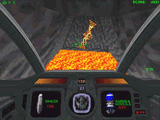The Graphics Accelerator
The market for graphics subsystems was, until the
advent of multimedia, relatively simple to
follow. First there was VGA,
developed by IBM in 1987, which made it possible
for graphics card manufacturers to offer higher
resolutions (640 x 480) and more on screen
colors. With the growth
in popularity of Windows there came a strong
demand for 2D hardware acceleration to offload
the host Central Processing Unit (CPU) of
graphics processing tasks, and increase the
overall performance of the Graphical User
Interface (GUI). The operating system of Windows
and its applications needed as much of the CPU
time as possible, and that was slowing down the
graphics. Manufacturers added
2D graphics functions to move Windows around the
screen much faster, hardware cursors to track the
movement of pointers across the display, and
processing power to fill areas of the screen with
color at much faster rates. Hence, the
Accelerated VGA (AVGA) chip was born, also known
as the Windows accelerator, or GUI accelerator.
The Windows accelerator is the staple product in
mainstream computing. Multimedia provided a
new set of graphics challenges by adding audio,
and digital video components to the 2D graphics
mix. Today
it is common to find that many AVGA products also
support digital video functions in hardware.
Therefore, if you have been used to seeing
postage sized video on your computer screen you
need to move up to the multimedia accelerator.
The multimedia accelerator normally has functions
that allow scaling of video in x and y directions
with hardware, and convert the video signal of
digital video into computer graphic RGB
components in hardware. Some may also have
hardware decompression of digital video as well.
The development of graphics subsystem has
followed a simple pattern partly dictated by the
size of the computer’s screen, partly
influenced by the GUI, and partly influenced by
graphics chips. The early VGA standard of 640 x
480 pixel resolution was adequate for the 14 inch
monitors that existed on most systems at that
time. As displays got bigger, resolutions got
higher. Today, 17 inch monitors are quite common
as are the 1024 x 768 resolution images that fill
them up.
From VGA to multimedia accelerators the trend
has been towards putting more visual information
on the screen. 3D is a continuation of that
trend. Large amounts of visual data can be
compressed into the physical space of a computer
screen if it is displayed in 3D. Real time 3D
graphics then lets users navigate through that
information with ease.
|
Games
Engines
The first rule of computer games is that there
are no rules. Traditionally, games developers are
more interested in the impact of their programs
rather than following engineering fashion.
Although there are many 3D APIs on the market
today, and Direct3D is getting a lot of
developers’ attention, some choose to create
their own 3D games APIs, or engines. The custom
games engine is one way for developers to get to
do the really imaginative feats of graphics
programming that push the design envelope to the
its outer edges.
There is nothing more satisfying to a games
developer than to be able to access directly the
hardware components of a system. Three big name
games developers have developed their own games
engines that work optimally with hardware
acceleration. Sega’s Virtua Fighter,
Papyrus’ NASCAR Racer, and Interplay’s
Descent II, are true 3D experiences. Each has its
own unique engine that makes the most use of
particular 3D graphics hardware acceleration.
No Compromise Graphics
While the talk of 3D graphics is exciting enough
in its own right, there is a new breed of product
coming to market that combines the best elements
of 2D, 3D and video. These products combine fast
2D graphics, surpassing the performance of
today’s Windows accelerators, with high
quality, accelerated 3D graphics, and digital
video playback at full frame rates. These
products are ushering in the era of no compromise
graphics and are making their way onto standard
desktop machines everywhere.
Companies, like S3, that have a rich history
of producing high performance graphics
accelerator chips for the PC, are leading the
market in compromise graphics technology. These
companies believe that 3D graphics acceleration
should not mean that traditional 2D graphics
speed need be forsaken. In fact, these companies
believe that fast 3D graphics require even faster
2D in order to be effective. No compromise
graphics is an attempt to ensure that all the
components of multimedia graphics run at
sufficiently high levels of performance to create
a compelling experience. S3’s ViRGE graphics
accelerator, for example, is one of the fastest
Windows accelerators on the market, yet, it is
recognized as a breakthrough 3D accelerator and
digital video engine. Ultimately, the aim of
manufacture
|


